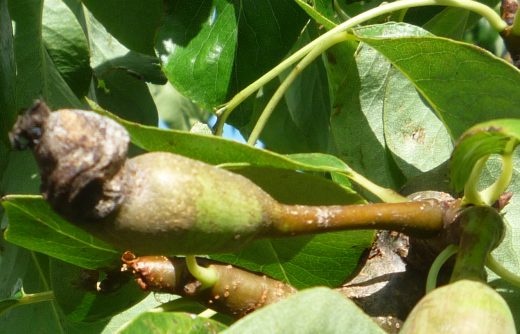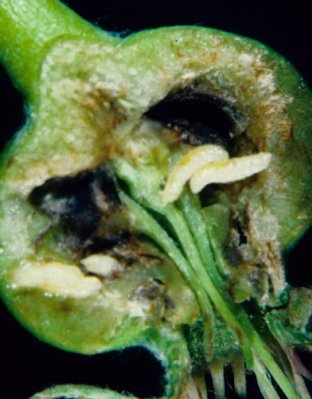SYMPTOMS OF PEAR TREE MIDGE
The first signs occur in mid-April time (it may differ depending on the variety) and they are difficult to spot. Affected fruits will be slightly larger than normal, have a more rounded appearance and are softer. Their shape may then start to distort and after a couple of weeks the lower end of the developing pear (the end furthest from the stalk) turns black. In May to June the fruits fall to the ground.

![]()
Pear Midge damage to fruit
If you take an affected fruit which is still on the tree (see above) and cut it open the signs of pear tree midge are then immediately unmistakable. There will be small, creamy white maggots in the centre and they will frequently be moving, not a very pleasant site at all as the picture below illustrates. They will have fed on the centre of the fruit effectively hollowing it out.
The only other pear tree problem which looks remotely like Pear Tree Midge is late frost damage. But in the case of frost damage there will be no maggots in any of the fruit and the interior of the cut open fruit will not be black.
LLIFE CYCLE OF PEAR TREE MIDGE
Understanding the life cycle of the Pear Tree Midge is the key to fighting it. Not only will it explain why certain preventative measures can reduce or eradicate this pest but it may even inspire you to come up with a solution yourself. The picture below shows a graphical representation of the pear tree midge lifecycle.

The following is a step by step description of the Pear Midge life cycle. This pest has only one generation each year:
- Adults emerge from the soil typically in mid-April as small flying midges (2.5 to 4mm long) which are both female and male.
- The flies congregate around a suitable pear tree and mate.
- Females lay eggs on blossom before it has fully formed.
- Eggs develop into maggots which feed on the young fruit which is forming.
- Maggots feed on the inside of the fruit causing it to swell, soften, distort, blacken and prematurely fall.
- Maggots eat their way out of the fallen fruit and burrow 5cm / 8cm (2 in to 3in) down into the soil surface.
- The maggots form cocoons and overwinter in the soil to emerge in April the next year as adult midges.
HOW TO TREAT PEAR TREE MIDGE
Once you notice the symptoms of this pest you need to accept that the damage has been done to this year’s crop. Disappointing but that’s the reality of the situation. Concentrate your efforts into reducing the damage to next year’s crop and hopefully eradicating the pests altogether. We strongly suggest that you use all the methods described below because this pest is a very capable adversary.
It’s important to understand that when a pear tree has been infested with Pear Tree Midge they will definitely be in the surrounding soil ready to attack your tree next year. They don’t go away of their own accord.
DESTROY INFECTED FRUIT
This will help to decrease the number of maggots which can over-winter in the soil. The objective of this stage of the treatment is to remove infected fruits from the tree before they fall to the ground. If they fall to the ground they should be collected and burnt but even so, some maggots will have escaped before you are able to do this.
Frequently examine the forming fruits from early April onwards (depending on the variety). If any show signs of being larger than normal, softer than normal (they should be very hard), malformed or with any black areas on them, pick them off the tree and burn them well away from any pear trees.
PLACE POLYTHENE ON THE GROUND
For maximum protection lay the polythene on the ground as far as the spread of the tree canopy from late April to early July. Hold it down with bricks or pegs. This will help to prevent any maggots from burrowing into the ground from fallen fruit.
SPRAY WITH AN INSECTICIDE AT THE CORRECT TIME
If you decide to spray with an insecticide, and in truth it is by far the most effective method to control this pest, then read this section carefully to ensure that not only is the insecticide effective on the Pear Midge but also that it does not kill bees. If you spray at the wrong time you may well kill bees and without bees you will not get any crop of pears. Just as important is to read the instructions and advice on the pack of insecticide.
The time to spray with insecticide is when the petals on the blossom are visible in a tight bud (known as the white bud stage) but before the blossom has opened. The picture below shows a typical pear blossom with most of the flowers being at the “tight bud” stage. There will always be the odd flower which has passed this stage and that can’t be avoided. But do not underestimate the damage done to your local bee population (and your crop of pears) if you spray too late.
The Pear Tree Midge lays its eggs on the unopened flowers of pear blossom and by spraying with an insecticide you will be killing the flies and therefore reducing the amount of eggs laid. Currently the insecticides available to gardeners for this purpose are those that contain deltamethrin or lambda-cyhalothrin. Try Bayer Sprayday Greenfly Killer (click here for their fact sheet) which is widely available at many garden centres and diy stores such as Homebase.
CULTIVATE THE SURROUNDING SOIL
Pear Tree Midges burrow 5cm to 8cm (2in to 3in) under the soil when they drop to the ground in May to June time. At this point the maggots are surprisingly mobile but when under the ground they spin a protective cocoon which is incapable of movement. Lightly cultivating the soil surrounding your pear trees with a trowel or similar will disturb the the cocoons and expose them to harsh weather conditions over winter which will frequently kill them. Some of the cocoons will be eaten by birds.
RESISTANT VARIETIES
It is clear that some varieties of pear tree are more vulnerable to Pear Tree Midges compared to others. The most likely to suffer to our knowledge are Williams Bon Chretien, Packham’s Triumph, and Beth. Less likely to be affected are Concorde, Doyenne du Comice and Onward.
OTHER PREVENTATIVE MEASURES
Some gardeners are driven to distraction by the Pear tree Midge and search out more unusual measures to combat them. Three methods, the last one admittedly very bizarre, are described below:
- Chickens are a very effective deterrent against this pest and they really do make a difference. The birds love to eat the maggots as the fruit falls prematurely from the tree.
- One writer has reported success by using a hoover with an extendable hose. This solution is based on the correct idea that the midges fly and mate in the hour or two before sunset. If you look around pear trees at the correct time the midges are visible and can be hoovered up in vast numbers. You will of course be considered totally mad by any people who see what you are doing but if it works then that’s a small price to pay!
- The most extreme solution we have heard of involves cement. Apparently one man became so obsessed with wiping out pear tree midges that one year around April time he covered the ground below his pear trees with cement. The theory was that this would prevent the maggots from burrowing into the soil. Not a solution we would recommend but you may differ.
COMMENTS / QUESTIONS LEFT BY OUR READERS
| Date: 13 June 2018 | From: John B |
| COMMENT: I have finally rid myself of these destructive pests after several years of trying unsuccessfully. I have two pear trees in the lawn. I went from just 6 uninfested pears off two trees in 2017 to several hundred uninfested in 2018. In fact only 11 were infested. Three pronged attack.1. Picked and destroyed all infested small pears in 2017 (about 5-10 mm diameter) hopefully before the maggots dropped. You need to pick and examine a lot and eventually you can tell whether one is infested before cutting it open.
2. Before the blossom opened in 2018, I cut the grass and sprayed the grass underneath the tree with Bayer Provado Ultimate Bug Killer available in most garden centres. I then covered the grass with clear plastic covering all the ground under the branches and a bit beyond. I also sprayed the tree and buds. The plastic stops the rain from washing the spray away and also traps any emerging midges close to the chemical which hopefully kills them. After about 10 days to 2 weeks I repeated this process. The spray under the plastic of course cannot harm the bees. 3. Despite this I still saw some swarms of midges close to the trees although much much smaller than previous years. I went out with normal household fly spray which seemed to dispose of them relatively easily. |
|
| Date: 21 June 2017 | From: Jackie B |
| COMMENT: 2 years ago I messaged you about my very old pear tree which had been attacked every year since I can remember. Since the midge lay eggs in the blossom I decided to de-blossom last year. This year it looks as though this may have broken the cycle. I am checking the fruit every day and so far all seems fine. Well worth a try! | |
WHY NOT LEAVE YOUR QUESTION / COMMENTS ABOUT THIS PAGE?
ENTER THEM BELOW. EMAIL ADDRESS IS OPTIONAL.
YOUR COMMENTS WILL BE ADDED ABOVE WITHIN A FEW HOURS.
[contact-form-7 id=”1882″ title=”Contact form 1″]


PEAR TREE MIDGE
By David Marks
Pear Tree Midges can destroy an entire pear tree crop year after year unless they are controlled. Unfortunately, in the first year they attack a pear tree, it will already be too late for that year’s crop by the time you notice the damage. The key is to accept the damage but plan carefully for the next year when it most definitely is possible to reduce their numbers and even eradicate them.
Their Latin name is Contarina pyrivora and it is at the maggot stage of their life that they do their damage.